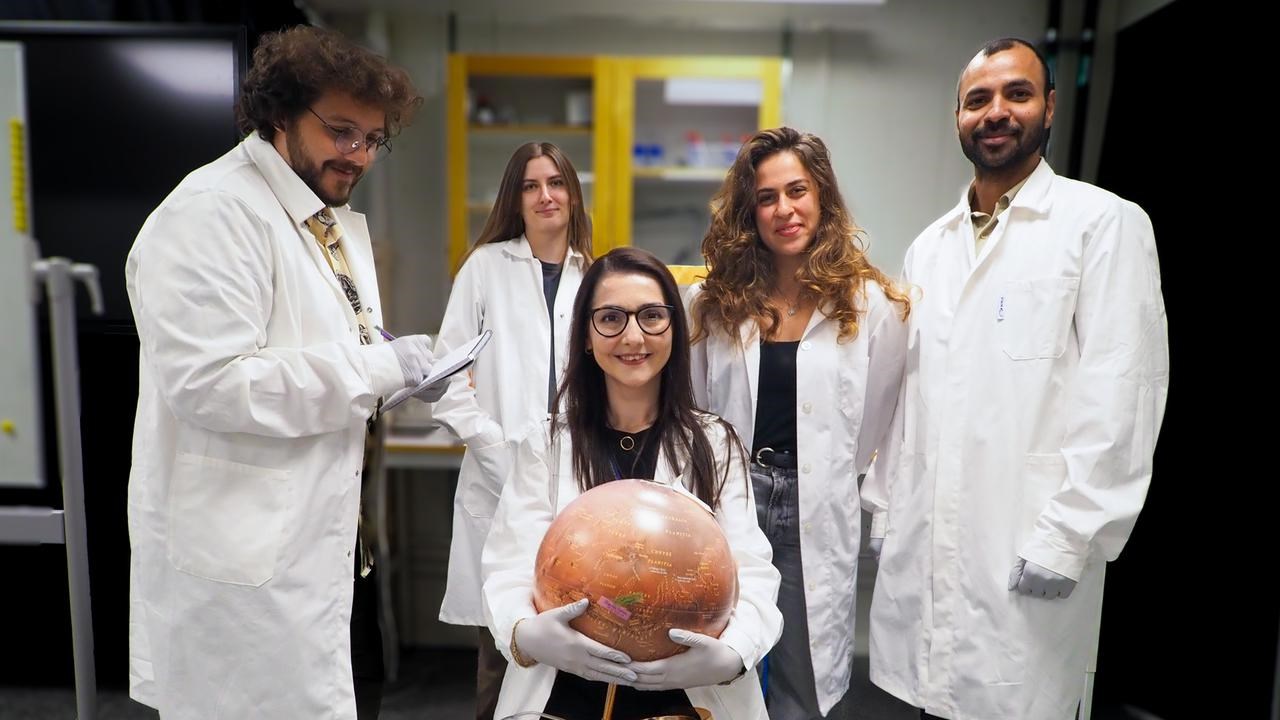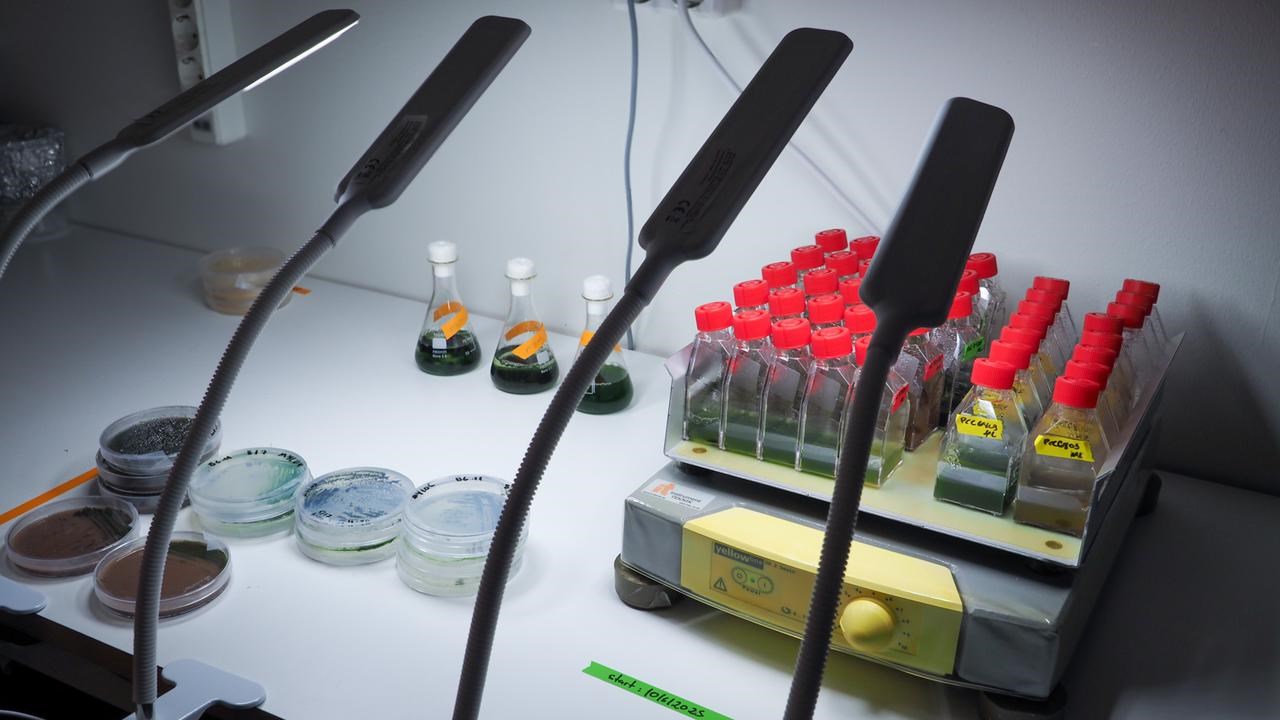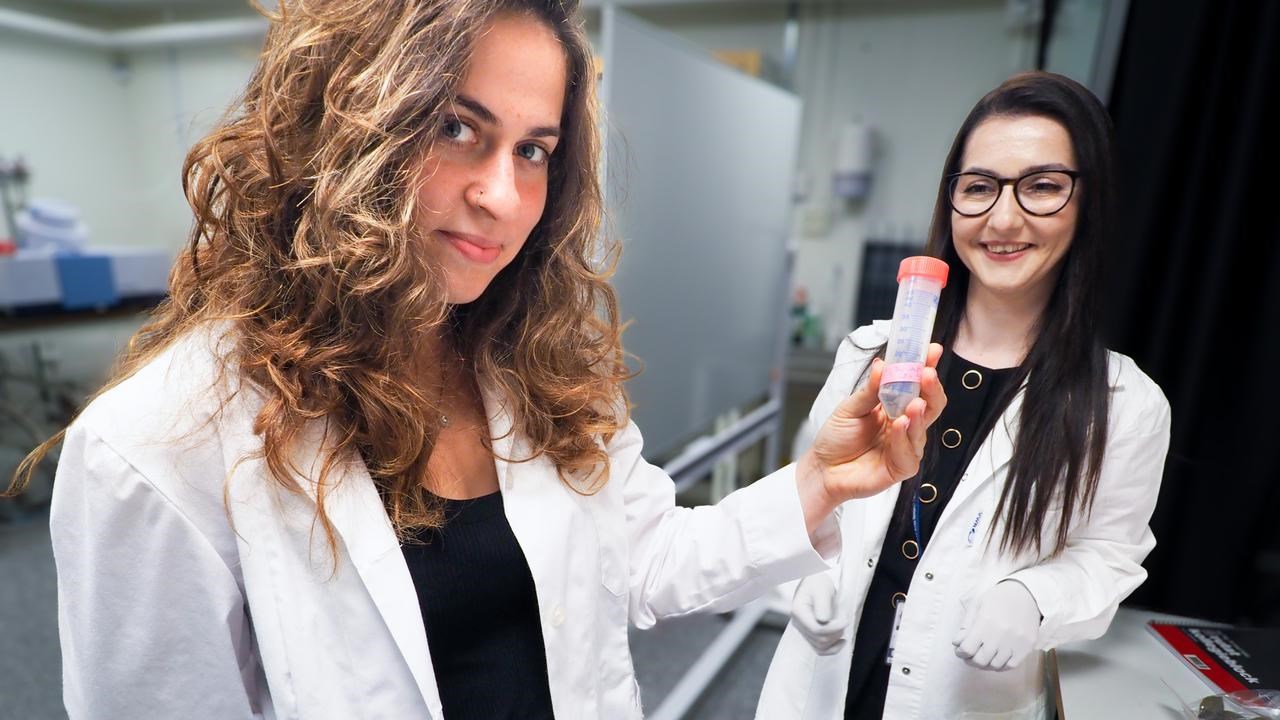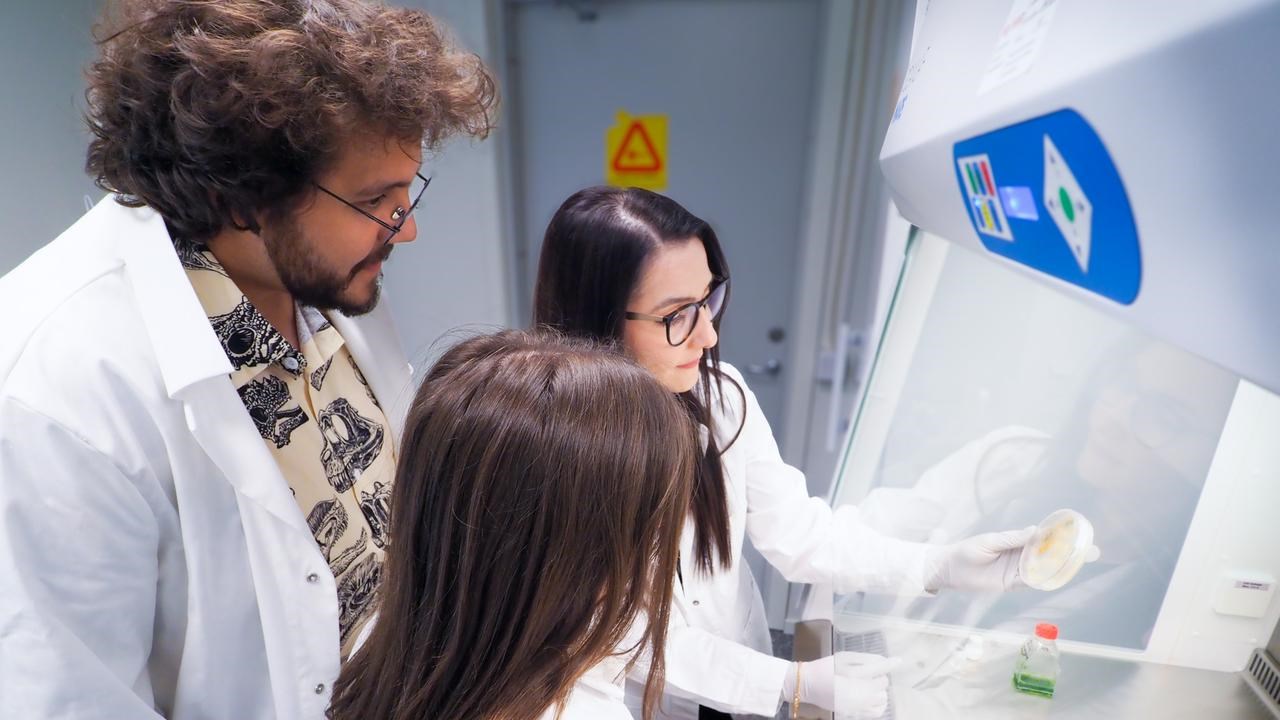NEWS In the cellar of the KBC building, a group of researchers are collecting signatures of life. In the windowless room, with artificial UV-lights, freezers and saline solutions, they put microorganisms like yeast and cyanobacteria through extreme environments, pushing them to their limits. Their goal? To discover biosignatures on their favorite planet: Mars.

Group leader and assistant professor Merve Yeşilbaş, postdoc Alef dos Santos, student assistant Frida Folkesson Ragnebrandt, PhD student Zoe Asimaki and postdoc Surendra Vikram Singh. Together, they are searching for biosignatures on Mars.
ImageRebecca Forsberg“We needed a place that is dark, cold and alone, just like space, so this is perfect,” laughs Merve Yeşilbaş, assistant professor at the Department of Chemistry, as she opens the door to her lab.
When she arrived in Umeå for the first time, in 2010, it was as an Erasmus student with the goal to study spectroscopy. It was a record cold January with metre-high piles of snow – extreme weather that set the course for her research. “Being born and raised in Istanbul, my dad joked that I was going the North pole,” she says.
Falling in love with spectroscopy in Umeå, her Erasmus turned into a master’s degree in physics and a PhD in chemistry. Ultimately, this led her to her childhood dream: NASA, where she spent 3 years as a postdoc. In 2022, Merve Yeşilbaş had just returned to Umeå and was setting up her own space lab in an old storage room.
Now, three years later, I visited the lab to see how far things have come, and to talk about mentoring, the vision of the lab, and of course: Mars.

In the space lab, bacteria and yeast are cultivated and exposed to UV, cold, and salty environments similar to those on Mars. What chemical signals do the microorganisms emit? By creating a catalogue of these signals, the hunt for life becomes clearer. ImageRebecca Forsberg
Merve Yeşilbaş radiates energy as she shows me around the lab. Her team – two postdocs, a PhD candidate and a student assistant – move between workstations where experiments are being prepared. In one corner, a newly installed spectrometer hums with a sign saying: “Experiment in progress.” A small Tintin figurine with his rocket to the Moon keeps watch besides a Mars globe covered in sticky notes.

Cyanobacteria cultivated in the lab.
Image Rebecca ForsbergPostdoc Alef dos Santos, with a background in organic chemistry, tends to cultures of cyanobacteria and bacteria from Antarctica, growing them in salty solutions similar to those on Mars.
“They are like my babies,” he says, explaining that on Earth cyanobacteria survive in some of the most hostile places imaginable – inside rocks, lava tubes and below the upper surface. “Perhaps it’s the same on Mars, waiting to be discovered underneath the surface” he says in an interview from earlier this year.
By another bench, PhD student Zoe Asimaki, with a background in biology and planetary science, is busy grinding rocks into fine powders.
– I’m preparing Mars regolith analogues, by exposing the powder to oxidation and radiation, she explains.

PhD student Zoe Asimaki has hammered and ground down rock into a fine powder. The purpose is to create dust – regolith – similar to that on Mars surface. ImageRebecca Forsberg
But what really makes the Yesilbas lab unique is its focus on ice. “We believe biosignatures on Mars will be found in the ice,” says Merve Yeşilbaş. Just as heat can drive chemical reactions, so can cold. Mars cycles through extremes, from –100°C nights to days that barely reach +20°C, repeatedly freezing and thawing. This process can trap salts, dust and organics within ice layers, preserving traces of life, or chemistry that resembles it.
“Ice chemistry is very fascinating,” says postdoc Surendra Vikram Singh, who, although he has a background in physics, now studies how RNA reacts to icy Martian conditions. “It’s key to understanding how and where we might detect life on Mars.”
“At NASA, I was taught to be a brave scientist, to ask outside-the-box questions and to dare to dream big,” says Merve Yeşilbaş, a legacy she is passing on to her team. “I feel a lot of trust from Merve in our ability to do the right thing, which gives freedom to explore and learn,” says Zoe Asimaki.

During the summer, Alef dos Santos, together with student assistant Frida Folkesson Ragnebrandt, studied extremophiles – organisms that survive in extreme environments on Earth. ImageRebecca Forsberg
The phrase “Extraordinary claims require extraordinary evidence”, popularised by astronomer Carl Sagan, is the foundation for the team's research. The spacelab does not work in a vacuum, and to get the most data out of their samples, the lab collaborates with several scientists, groups and infrastructures at the Chemical-Biological Centre. “Having close access to infrastructures like the Swedish Metabolomics Centre, NMR, UCEM, and the expertise of the helpful staff scientists, is invaluable for our research,” says Alef dos Santos.
Having a diverse set of backgrounds is what makes the team so successful. “In a way you have to shift your identity, from being a biologist to something more diverse” says Zoe Asimaki. “Although reading papers that are outside of your own field might take a bit longer, we get help from each other and in the end, we know more as a team.”

Space is ever-present in the lab, with Tintin’s Moon rocket and the Mars globe on display.
Image Rebecca ForsbergThe aim of the lab is to build a catalogue of both abiotic and astrobiological signatures – traces of processes that are biological in origin, and those that are not. “On broad terms, we are pioneering the way we search for life,” Zoe Asimaki says, Merve Yeşilbaş filling in: “The key is to have a common vision, sharing a goal. I believe that the learning progress is endless, and every day we explore together.”
Today, the lab is filled with ambition and laughter. “I’ve made this room into my happy place, where everything is possible. Now, I’m in a good place,” says Merve Yeşilbaş.

Surendra Vikram Singh researches how RNA reacts to icy Martian conditions
Image Rebecca ForsbergStudent assistant Frida Folkesson Ragnebrandt describes the atmosphere as supportive. “Everyone shares the fascination with space, and that makes it fun to come here”.
So where is the lab going next, up and beyond? Together, they are preparing for the next generation of Mars missions, aiming to equip ESA and NASA with tools and constraints for detecting reliable biosignatures. Merve Yeşilbaş, who still collaborates closely with NASA, hopes to expand the lab, and continue to influence and be involved with future Mars- and space missions.